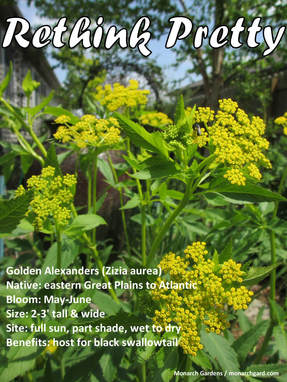In addition, many specialist bees have evolved relationships with specific native plants, timing their life cycles for when pollen is available from those plants. Specialists are incredibly crucial to keeping the pollinator system in balance, and when we lose even one such species pollination rates for plants suffer. Need one even mention the benefit of native plants as larval hosts to a variety of insects and bugs?
Additional research shows that dandelion pollen has allelopathic properties (which it also has in its roots and tissue), and when spread to other plants reduces seed production. S
There are a plethora of native plants that either bloom at the same time as dandelion or weeks earlier. The below list of plants represents a range primarily in the eastern half of the continental U.S. (but often beyond), with a special focus on the Midwest.
Trees & Shrubs
Native Willows (Salix spp.)
Red Maple (Acer rubrum)
Red Elderberry (Sambucus racemosa)
Native Currants or Gooseberries (Ribes spp.)
American Plum (Prunus americana)
Chokecherry (Prunus virginiana)
Native Viburnum (Viburnum spp.)
Native Dogwood (Cornus spp.)
Serviceberry (Amelanchier spp.)
Leatherwood (Dirca palustris)
Prairie / Savanna Perennials & Biennials
Prairie Smoke (Geum triflorum)
Pussytoes (Antennaria neglecta)
Golden Alexanders (Zizia spp.)
Wild Lupine (Lupinus perennis)
Pasque Flower (Anemone patens)
Marsh Marigold (Caltha palustris)
Early Buttercup (Ranunculus fascicularis)
Cleft Phlox (Phlox bifida)
Azure Bluet (Houstonia caerulea)
Longleaf Bluet (Houstonia longifolia)
Violet Wood Sorrel (Oxalis violacea)
Prairie Dandelion (Nothocalais cuspidata)
Prairie Blu-Eyed Grass (Sisyrinchium campestre)
Woodland Perennials / Ephemerals (perfect for shady urban lots)
Bloodroot (Sanguinaria canadensis)
Dutchman's Breeches (Dicentra cucullaria)
Native Violets (Viola spp.)
Jacob's Ladder (Polemonium reptans)
Large-Flowered Bellwort (Uvularia grandiflora)
Wild Geranium (Geranium maculatum)
Bishop's Cap (Mitella diphylla)
Virginia Bluebells (Mertensia virginica)
Virginia Waterleaf (Hydrophyllum virginianum)
White Trout Lily (Erytronium albidum)
Yellow Trout Lily (Eryhronium americanum)
Spring Beauty (Claytonia virginica)
Sharp-Lobed Hepatica (Hepatica acutiloba)
Robin’s Plantain (Erigeron pulchellus)
Twinleaf (Jeffersonia diphylla)
Early Meadow Rue (Tahlictrum dioicum)
Solomon’s Plume (Maianthemum racemosum)
To learn more about sustainable wildlife gardening, check out some 200 articles or try one of these 5 online classes.



 RSS Feed
RSS Feed

